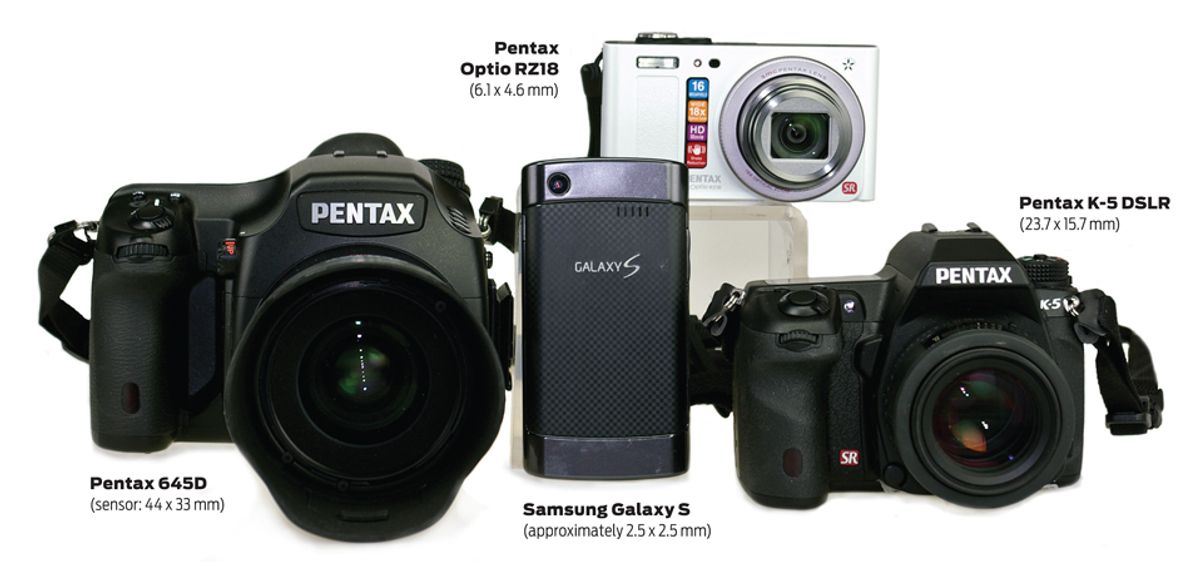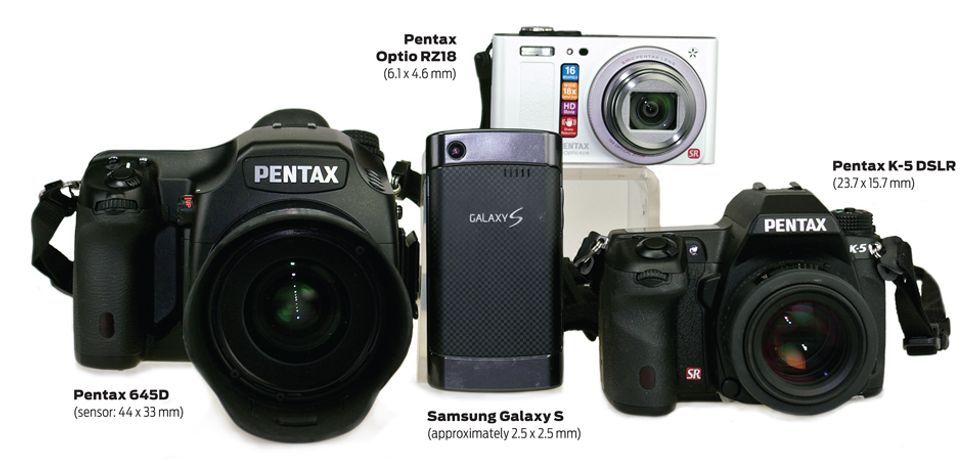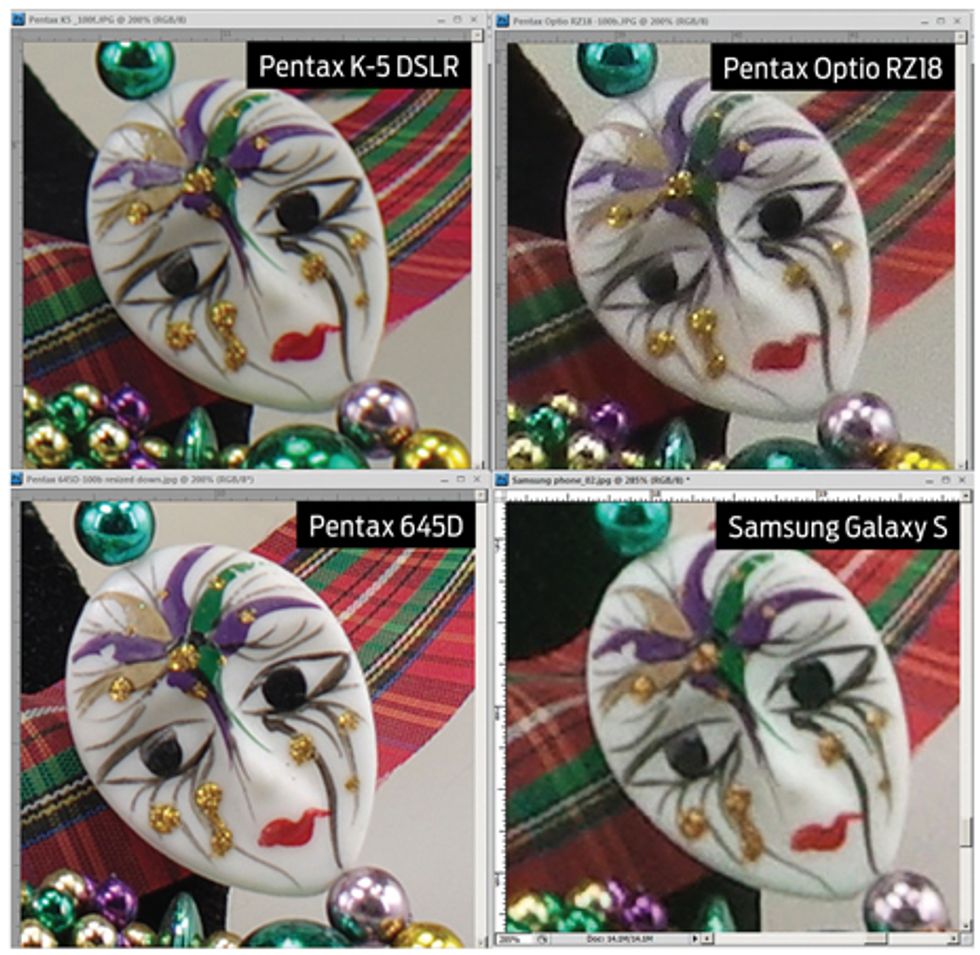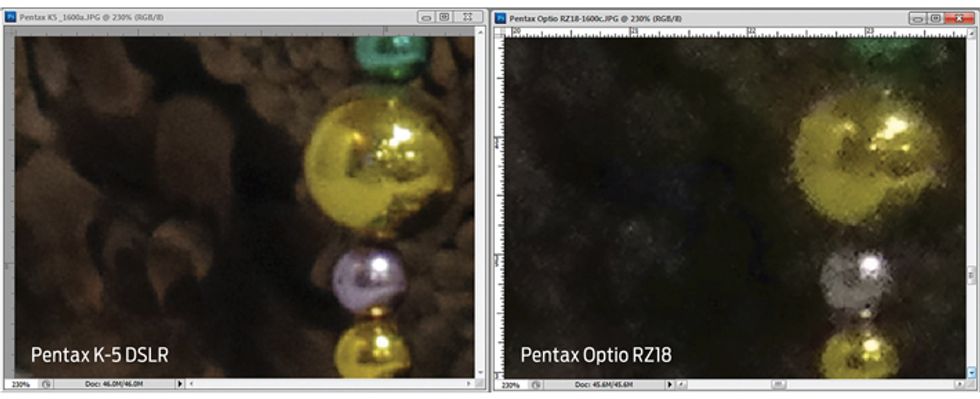The metric most often used by camera manufacturers and marketers to tout their products has been pixel count. That’s a shame, but it was probably inevitable—it’s easy to measure, and consumers are used to the idea that more is better. However, the number of pixels is a measure of quantity, not quality.
To be sure, in the beginning—the 1990s—there was a great need for more pixels. But by 2000, pixel counts plateaued at 3.3 megapixels. At that number, the sensor was relatively cheap to produce, and the resulting images had just enough resolution for decent 8½- by 11-inch color enlargements from inexpensive inkjet photo printers. For a while, manufacturers competed not on size but with new features, such as geotagging, optical image stabilization, extended zoom ratio, and video. Then pixel escalation resumed with a vengeance. Nowadays, 12-, 14-, and 16-megapixel point-and-shoot digitals are the rule rather than the exception, and cellphones routinely offer 5-, 8-, and even 12-megapixel resolution.
What manufacturers didn’t bother explaining was what a pixel is—and why we should care how many we have. Essentially, at the heart of every digital camera is an image sensor. The lens focuses photons reflected by the scene being photographed onto that image sensor. Etched into the image sensor’s silicon are pixels (short for “picture elements”)—technically, photoreceptor or photodiode sites. Each pixel is a single point that collects the electrons, which are then interpreted into information about color and light. As in the Postimpressionist style of pointillism, which used thousands of paint dots to create a work of art, the signals from pixels are processed into a recognizable image. The more pixels, the more information collected and the larger the photo.
But bigger pictures don’t necessarily mean better pictures. In fact, pixel count alone cannot ensure a quality image. If it were otherwise, then a US $139 16-megapixel Nikon Coolpix S3300 point-and-shoot camera would produce pictures as good as those from a $5995 professional Nikon D4 digital single lens reflex (DSLR) with the same number of megapixels. Or, to take the comparison to an even greater extreme, the recently unveiled (and still unpriced) 41-megapixel Nokia 808 PureView smartphone (yes, Virginia, there is a 41-megapixel phone camera) would have image quality similar to that of a $17 500 40-megapixel Phase One 645DF camera. Some obvious differences account for the higher prices of the Nikon D4 and the Phase One 645DF: much faster performance, higher quality construction, more durable body, superior ergonomics, more precise settings and adjustments, interchangeable lenses, and so on. But those factors don’t explain the most important advantage: vastly superior image quality.
If the number of pixels doesn’t directly relate to image quality, what does? Actually, there are several factors that define and determine a digital camera’s image quality: the physical size of the pixels and the image sensor, the filters (and usually the microlenses) bonded to the image sensor, the firmware that processes pixel data, and the camera lens.
But it all centers on the individual pixels.
Pixels on an image sensor are analogous to a bunch of red, green, and blue paint buckets placed side by side. (Red, green, and blue combine to create all colors.) The bigger the buckets, the more paint (electrons) they can capture.
Here’s where it gets a little tricky, so it’s best to explain by another analogy. Suppose you need to estimate how much rain falls onto a farm, and you have only a minute’s worth of rainfall to do your measurements. Imagine that you spread 100 empty soup cans around the property, capped by funnels that are 10 centimeters in diameter. You might collect only a few hundred drops in each. Now suppose you could double the size of the funnel. The amount that can be collected increases exponentially. Calculating how much rain falls on the field by extrapolating the water collected with, say, 1000‑cm funnels will yield vastly more accurate results. Here’s why: If your raindrops are really photons, the signal-to-noise ratio is dominated by the fact that the noise is equal to the square root of the number of photons. Thus the more rain each soup can collects, the higher the signal-to-noise ratio.
Similarly, large pixels collect more electrons than small pixels, so the point when the pixel flips from a 0 to a 1 can be much more precise. That in turn means far less data processing. With small pixels, the camera’s firmware is forced to extrapolate data.
What’s more, there are technical complications that can affect the amount and quality of the data collected. For instance, on CMOS image sensors, electrons must first pass through a layer of metal wiring before being collected in the photoreceptor site. Some electrons can be deflected or absorbed and need to be re-created via image-processing firmware. While modern cameras have far better firmware than their predecessors, extrapolation is still at best an imperfect process. When the software guesses wrong, an image can have the wrong colors, lose detail, or produce visual artifacts like purple fringing.
It’s axiomatic that at a given number of pixels, the larger the image sensor, the larger the individual pixels can be. Conversely, the smaller the image sensor, the smaller the pixels. What’s more, cramming the same number of pixels into a much smaller area introduces other challenges that can generate technical errors, such as noise (electronic chaff) and blooming (light spilling off the sides of the pixels), which in turn lead to image degradation. Conversely, larger pixels and image sensors enhance image quality by producing a higher signal-to-noise ratio, greater dynamic range (the ability to capture details in the highlights and shadows), and truer colors. Higher-priced cameras have other advantages in addition to physically larger image sensors: better lenses with superior optics, better color filters and microlenses bonded onto the image sensor, and more advanced firmware.
To demonstrate all this, we grabbed four cameras from our studio. The first two were a $180 16-megapixel Pentax Optio RZ18 compact camera with a built-in 18X zoom lens and the $1000 16.3-megapixel Pentax K-5 DSLR with a 50-millimeter lens. (We used Pentax cameras for our tests because Sally already had them in the studio on a long-term loan; Pentax is an in-kind sponsor of Sally’s American Hands fine art project.)
We set up a still-life scene that covered the full potential of dynamic range, including specular highlights and lots of detail in highlights, midtones, and shadows. Since the two camera lenses have different focal lengths, we adjusted each camera so that the still life covered approximately the same percentage of the viewfinder (hence a similar number of megapixels were used to capture the different elements of the scene). We put the cameras on a rock-solid camera stand and used their self-timers, to ensure that the act of taking the pictures caused no motion blur. Then we took a series of photographs, first with studio lights at 100 and 400 ISO equivalencies and then without lights at 100, 400, and 1600 ISO. The cameras were set for comparable exposures.
Out of curiosity, we also took the same series of photographs with two other cameras: a $12 500 medium-format 40-megapixel Pentax 645D (with a 55-mm lens) and the 5-megapixel camera in Sally’s $200 Samsung Galaxy S phone. (The phone has no ISO settings or tripod socket, so we carefully propped it on the camera stand, with and without lights but with no sensitivity adjustments.) The four image sensors cover quite a range of sizes, from 44 by 33 mm (for the Pentax 645D) to about 2.5 by 2.5 mm for the smartphone. (Samsung does not provide image-sensor size information, but it is quite tiny, about the size of a BB pellet.)
Under studio lights that gave ideal daylight illumination, each of the four cameras captured an attractive photograph when viewed on a computer screen at snapshot size. This did not surprise us—just about any camera can give you a decent picture in good light, if all you want to do is view it on a computer monitor. It’s under magnification, when you want to print your photos, or if you are photographing under poor lighting that the differences among cameras become evident.
Even with studio lighting, of the two 16‑megapixel cameras, the K-5 DSLR’s larger image sensor (and better lens) captured more detail and less noise than the Optio’s. But under low light, shot at 1600 ISO, the differences between the DSLR and the compact camera were extreme, with the Optio’s shadow details completely lost. The 40-megapixel 645D did even better, even when we downsized the photos so they were the same resolution as those from the 16-megapixel Optio compact. The precision of capture with the larger image sensor and stellar optics of the 645D far outshone all the others and did so under all lighting conditions. Indeed, we’re confident the same thing is true at the small end: The advantages of a comparatively larger image sensor, larger pixel size, and a better lens are so great that a compact camera would have done a job significantly superior to the phone’s camera even at the same 5-megapixel size.
So it makes a huge difference if your image sensor is the size of a BB pellet, a Chiclet, a postage stamp, or a tea cookie. Luckily, you don’t have to research the Internet or white papers to find out the size of a camera’s image sensor (a figure that not all manufacturers readily provide). Just look at the lens. Technically, an image sensor is a component in the camera’s optical system. As such, it must match the lens. The diameter of the lens at the point where it is attached to the camera will give you an indication of the size of the image sensor.
For professional and fine art photographers who must have absolutely top quality photos and are likely to produce large prints, the difference in image quality offered by big image sensors (plus their matching superior lenses, better firmware and such) is critical. We’ve found that serious hobbyists are often just as particular as pros when it comes to getting the best possible picture their budgets can afford. For everyone else, whether or not the size of your pixels matters will depend on your plans to shoot in less-than-ideal lighting conditions or to print enlargements, or if you really care about details in your pictures. If all that’s really important to you is that the baby is beaming, reach for the smartphone that’s always in your purse or pocket.
This article originally appeared in print as "Not All Pixels Are Created Equal."






